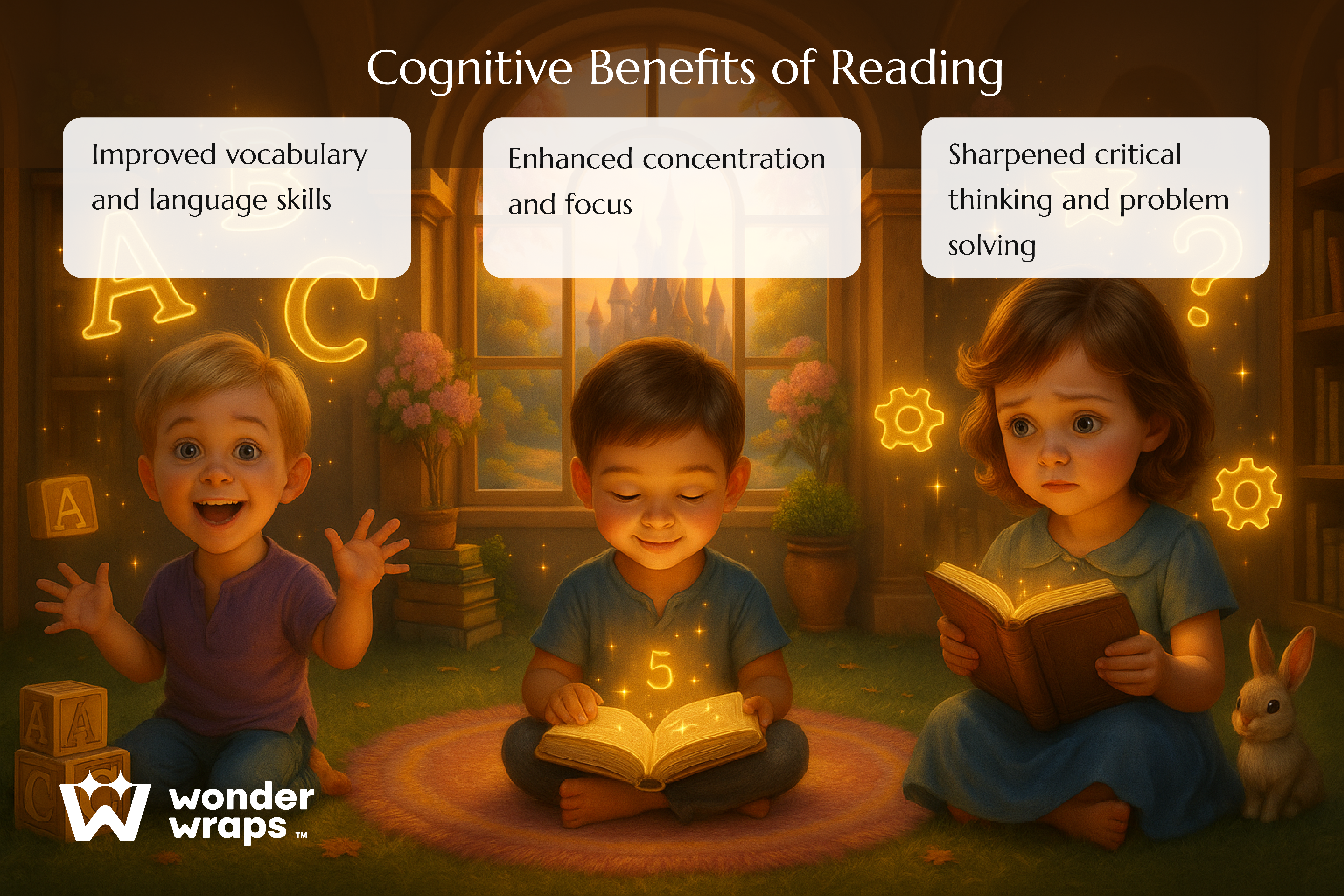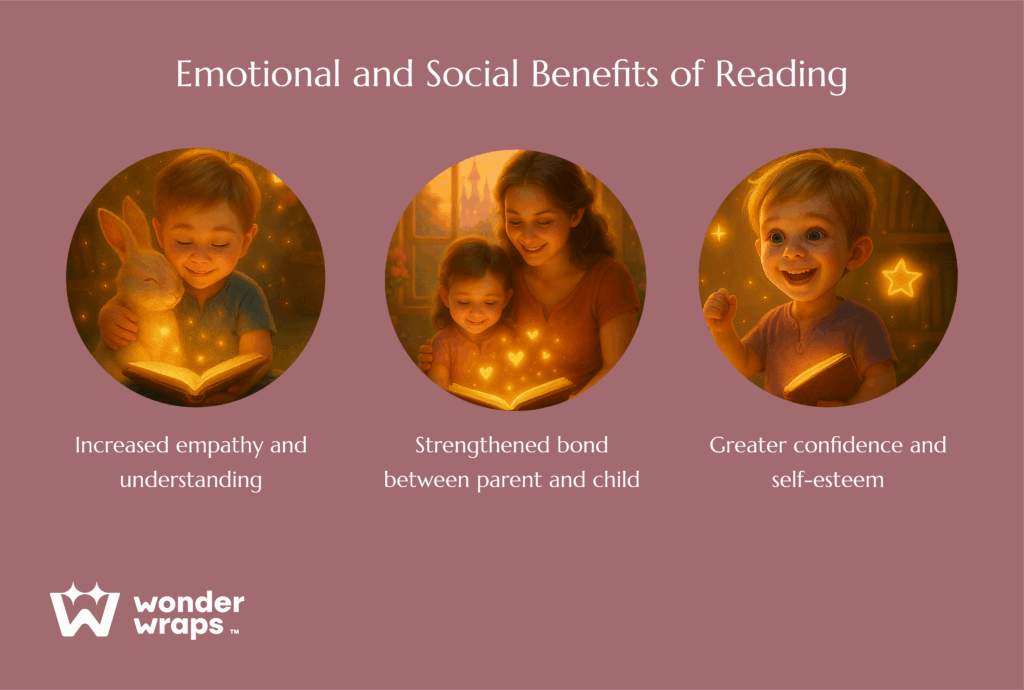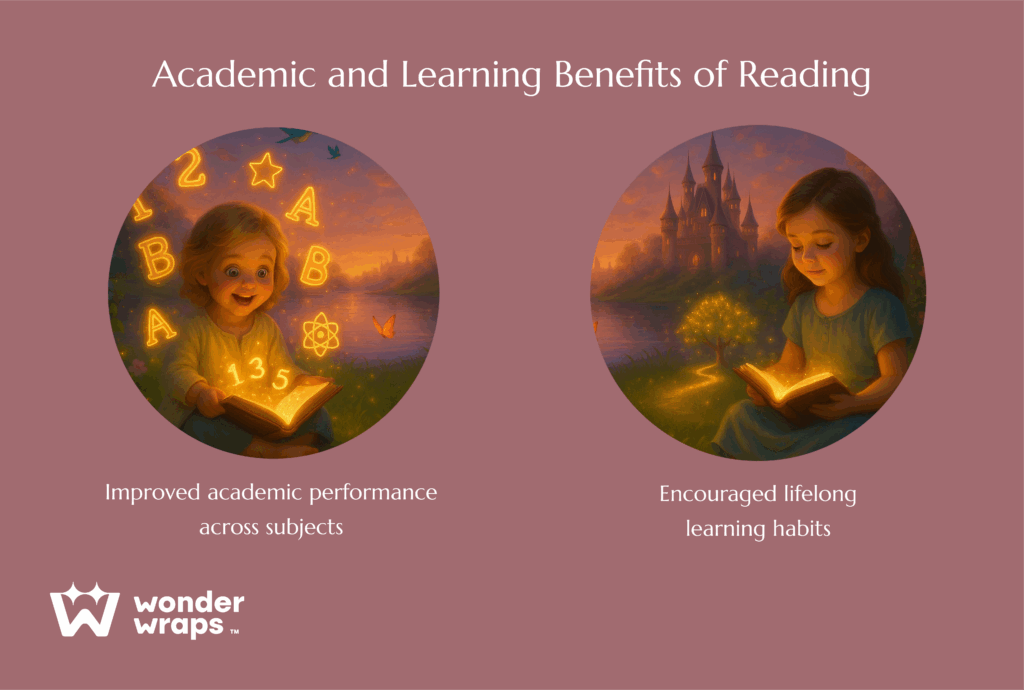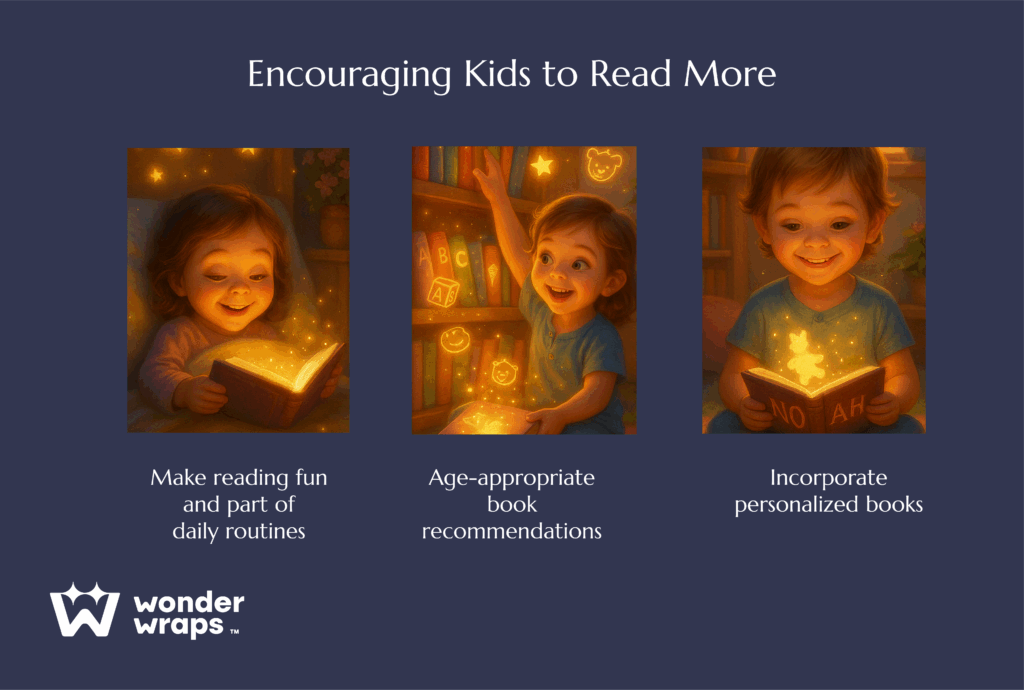Key Takeaways
- Reading sets kids up for school success. Regular reading helps children do better not only in reading and writing but also in subjects like math, science, and social studies.
- Books grow empathy and confidence. Stories let children see the world through different perspectives while also creating special bonding moments during family reading time.
- Stories spark imagination for life. Childhood reading fuels creativity, problem-solving, and a love of learning that can inspire future achievements.
Every parent hopes to give their child the strongest possible start in life, and few gifts are as powerful as a love of reading. The benefits of reading for kids extend far beyond simple entertainment; they shape how children think, learn, and connect with the world around them.
From building vocabulary and critical thinking skills to strengthening family bonds during bedtime stories, reading creates a foundation for lifelong success. Whether it’s a bedtime tale whispered together or a child’s first steps into independent reading, these precious moments become building blocks for your child’s emotional and intellectual growth.
Let’s look at why reading matters so deeply and how you can make it a joyful part of your family’s everyday life.
Cognitive Benefits of Reading

Reading works like exercise for your child’s growing brain. Each page strengthens neural pathways, sharpening essential thinking skills that will support them for a lifetime.
Improves vocabulary and language skills
Children who read regularly are exposed to far more words than those who don’t. A study by researchers at The Ohio State University found that children who are read one picture book every day hear an estimated 78,000 more words annually. Over the five years before kindergarten, this accumulates to children hearing approximately 1.4 million more words compared to those who are not read to regularly.
Books also introduce children to complex sentence structures, varied grammar patterns, and descriptive language that go well beyond what they hear in daily conversations. Over time, these patterns become part of their own communication toolkit, making them stronger speakers and writers.
Enhances concentration and focus
In our screen-filled world, reading helps children develop sustained attention spans. Following a story from beginning to end requires focus and patience, skills that transfer directly to classroom learning and homework completion.
Unlike fast-paced digital media, books invite children to slow down, process information deeply, and stay engaged with one activity for extended periods. This concentration practice becomes invaluable for academic success.
Develops critical thinking and problem-solving
Stories present children with complex situations where characters face challenges and make decisions. As young readers follow along, they naturally begin predicting outcomes, analyzing character motivations, and thinking through “what if” scenarios.
This mental exercise builds analytical thinking skills that children apply to real-life situations, from playground conflicts to academic challenges.
Emotional and Social Benefits

Reading doesn’t just nurture bright minds; it also nurtures emotionally intelligent, empathetic, and confident children.
Builds empathy and understanding
When children read about characters from different backgrounds, cultures, and life experiences, they develop empathy and emotional intelligence. They learn to see the world through other perspectives and understand that people have different feelings, challenges, and motivations.
This emotional growth is particularly important in our diverse world, helping children become more compassionate and socially aware individuals.
Strengthens parent-child bonding
Shared reading time creates special moments of connection between parents and children. These quiet, focused interactions build trust and communication and associate learning with love and security.
The closeness of sitting together, turning pages side by side, and experiencing a story as one strengthens the parent-child relationship while creating lasting memories that your child will treasure.
Boosts confidence and self-esteem
As children progress in reading, every book they finish brings a sense of mastery and pride. The moment they read independently for the first time is a milestone that fills them with accomplishment.
For children who see themselves reflected in personalized children’s books, this effect is even stronger. Becoming the hero of their own story reinforces self-worth and instills the belief that they can face challenges (both in stories and in life) with confidence.
Academic and Learning Benefits

The connection between reading and academic success is undeniable: children who read regularly outperform their peers across multiple subjects.
Improves academic performance
Students who read frequently show better performance not just in language arts, but in math, science, and social studies too. Reading builds the comprehension skills and background knowledge necessary for understanding complex academic concepts.
Research shows that children who enter school with strong reading foundations tend to carry those advantages with them year after year. Put simply, reading habits, along with good study skills, play a big role in how well students perform across all subjects, and the more kids read, the more confident and successful they become in school.
Encourages lifelong learning habits
A love of reading developed early often turns into a lifelong habit of learning. Children who read regularly become comfortable with discovering new information through text, and they cultivate the patience required for deep, sustained learning.
This habit pays off in higher education and professional life, where adapting to new knowledge and skills is critical. A strong reading foundation nurtures curiosity and equips children to thrive in environments that demand continuous growth.
Imagination and Creativity
Beyond academics, children’s books nourish creativity by opening doors to worlds where anything is possible.
How stories fuel imagination and creative thinking
Each time children read, they actively construct mental images of characters, places, and events. This visualization process strengthens their imagination and creative thinking abilities.
Unlike movies or video games, which present ready-made visuals, books require children to engage their minds in building the story world. This active participation becomes a lifelong exercise that strengthens their creative “muscles.”
Examples of children inspired by books
Many successful artists, writers, inventors, and entrepreneurs trace their creativity back to childhood reading experiences. J.K. Rowling, for example, was an avid reader who transformed her love of stories into the beloved Harry Potter series.
As the famous saying goes:
“If you want your children to be intelligent, read them fairy tales. If you want them to be more intelligent, read them more fairy tales.”
When children see characters overcoming challenges, exploring new worlds, or inventing creative solutions, they internalize the message that they too can imagine and create amazing things. A book becomes more than paper and ink; it becomes a springboard for ambition, a safe space for dreaming, and often, the very foundation of lifelong creativity.
How to Encourage Kids to Read More

Creating a reading-friendly environment at home can make all the difference in nurturing your child’s love for books.
Make reading fun and part of daily routines
Establish consistent reading times that become anticipated parts of your day; perhaps after breakfast, before nap time, or as part of the bedtime routine. Consistency helps reading become a natural, expected part of life rather than a chore.
Create cozy reading spaces with comfortable seating, good lighting, and easy access to books. Let children choose their own books sometimes, even if they pick the same story repeatedly. This choice gives them ownership over their reading experience.
Age-appropriate book recommendations
For toddlers (ages 1-3), choose books with simple text, bright pictures, and interactive elements like flaps or textures. Board books work well for this age group.
For preschoolers (ages 3–5), the best books are the ones with slightly longer stories that have rhyming text, predictable patterns, and engaging illustrations. Picture books that carry a full story help develop attention and comprehension.
Early readers (ages 5-8) benefit from books with larger text, shorter chapters, and plenty of illustrations to support comprehension.
Incorporate personalized books
Personalized children’s books can bring an extra spark to story time. When kids see their own name and image woven into the story, they connect more deeply with the characters and plot. This sense of recognition fuels engagement and makes reading even more exciting.
These special books also make wonderful keepsakes and gifts, showing children that books can be treasured possessions.
Wrapping Up
The benefits of reading for kids are truly transformative, touching every aspect of their development from language skills and academic success to emotional intelligence and creativity. By making reading a regular part of family life, you’re giving your child skills and strengths they will carry with them forever.
Even 15 minutes of shared reading time each day can spark big results. Adding personalized books into the mix can make those minutes even more magical, giving your child the joy of seeing themselves as the hero of the story.
Ready to spark a lifelong love of reading? Explore our personalized storybooks and watch your little one become the hero of their very own adventure.
Frequently Asked Questions (FAQs)
At what age should kids start reading?
Children benefit from reading as early as infancy, with parents reading aloud to strengthen language skills and bonding.
How much time should kids spend reading daily?
Aim for at least 20-30 minutes of reading time daily, which can include both independent reading and being read to by parents.


